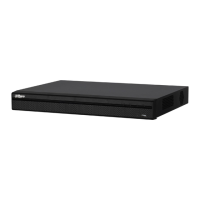User’s Manual
25
No. Port Name Function
2
1–16
Four groups of alarm input ports (Group 1: port 1 to port 4; Group 2:
port 5 to port 8; Group 3: port 9 to port 12; Group 4: port 13 to port
16). These ports receive the signal from the external alarm source.
There are two types: NO (Normally Open) and NC (Normally Closed).
When your alarm input device is using external power, make sure the
alarm input device and the DVR connect to the same ground.
Alarm output port
1–3 (NO1–NO3;
C1–C3)
Three groups of alarm output ports. (Group 1: port NO1–C1,
Group 2: port NO2–C2, Group 3: port NO3–C3).
output alarm signal to the alarm device. Make sure power
supply to the external alarm device.
NO: Normally open alarm output port.
C: Alarm output public end.
Ground.
3 Video input port Connects to analog camera to input video signal.
4
Audio input port
Receives audio signal output from the devices such as microphone.
5
Audio output port
Outputs audio signal to the devices such as the sound box.
6 HDMI port
High definition audio and video signal output port.
The port outputs the uncompressed high definition video and multi-
channel audio data to the connected display with HDMI port.
7 USB port
Connects to the external devices such as keyboard, mouse, and USB
storage device.
8 Network port Connects to Ethernet port.
9
RS-485
communication
port
Connects to the control devices such as speed dome PTZ. RS-485_A
port is connected by the cable A and RS-485_B is connected to the
cable B.
10 Power input port Inputs 12 VDC power.
11 VGA port Outputs analog video data to the connected display with VGA port.
12 Power button Turns on/off the DVR.
13
Power cable
fastener
Use clamp to secure the power cable on the DVR in case there is any
loss.

